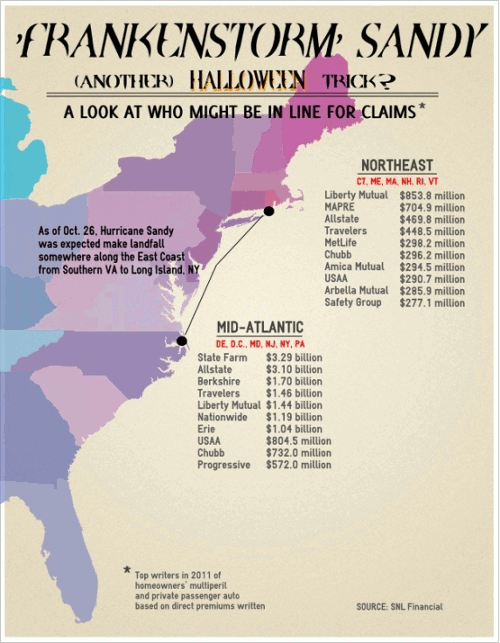Hurricane Sandy is now an extra-tropical storm, currently positioned in south east Pennsylvania and forecast to slowly move through that state towards the Great Lakes. Sandy still has winds of up to 65mph with some higher gusts, is still a large and damaging storm and still threatens extreme rains and also snow further north. New York and New Jersey appear to have taken the brunt of the storms storm surge and damage. Across the U.S. reports suggest that over 6 million people remain without power.
Putting a figure to the damage caused by Sandy is going to be very difficult, latest estimates continue to suggest an economic loss of up to $20 billion and an insured loss of up to $10 billion. That’s on top of an estimated up to $500m of insured losses in the Caribbean. However, the economic loss number could be much higher once the full damage is assessed. Also it must be notes that the estimate for up to $10 billion of insured losses was released before Sandy struck and before the extent of damage was understood. There is also the issue of insured versus NFIP losses from flooding and how much of the economic loss will be picked up by the authorities, particularly in the NY transit system. Then, how much of the economic loss passes through insurers and on to reinsurers is another factor to consider.
Impacts to New York city from the storm surge that Sandy pushed into the harbour were worse than expected. The Mass Transit Authority reports that seven tunnels under the NY east river are flooded. The entire NY subway system remains closed and many stations have been flooded, particularly in Lower Manhattan and Brooklyn.
In New Jersey, there was extensive storm surge flooding in coastal areas such as Atlantic City. A levee has broken on the Hackensack river flooding the three towns of Moonachie, Little Ferry, and Carlstadt with around five feet of water. There is currently a rescue operation underway.
Other neighbouring states have suffered similar damage but news is coming in slowly as the storm is still impacting many areas with severe weather and rainfall.
In terms of exposure, an update just in from risk modeller RMS says that New York city alone has $2.1 trillion worth of insured property, mainly comprising of commercial/industrial buildings. Another firm, CoreLogic, said that in the seven mid-Atlantic states there is as much as 284,000 total residential properties valued at almost $88 billion potentially at risk. So the exposure is huge, the storm was much bigger than expected and damage from Sandy will continue through today, although lessening as the storm weakens, but then further flooding will likely become a concern.
Sandy is going to prove a test for the primary insurers with major exposures in these areas. Sandy will test their claims processes, their own underwriting diligence in terms of over-exposures and their risk transfer preparations. Some insurers have very large exposures in these states and the losses are likely to spill over to reinsurers, collateralized players may take a portion and possibly the catastrophe bond market.
The image below shows the insurers with the most exposure in the region:

Insurers with large exposure to hurricane Sandy - Source: SNL Financial
Specifically on the cat bond market, it is still early to tell what, if any, impact there might be to any exposed catastrophe bonds. It’s thought that if there is an impact it would be to aggregate cat bonds, either by adding to qualifying losses or by eroding protective retention layers beneath the cat bond structure, thus making them more risky. We’ll update you on any news that emerges on specific cat bond impacts.
For reinsurers Sandy could put some upward pressure on rates at the upcoming January renewals if indeed the industry loss is around the $10 billion mark. It won’t make a meaningful impact at that level across the board, but it would push up rates for U.S. east coast hurricane cover. It will be interesting to see if cat bond investors demand a premium for future U.S. hurricane cat bonds as well.
We likely won’t report much further on the weather aspects of Sandy, focusing more on the damages that have occurred and the impact to re/insurance and catastrophe bonds as reports on the extent of the damage are released.
Here are a few of our other Sandy related articles from yesterday:
– Catastrophe bond indices both decline on Sandy’s approach
– Catastrophe bond market participants comment on Sandy
– EQECAT estimates Sandy insured loss $5B-$10B comments on cat bonds
Here are a number of weather maps and resources showing current conditions over the U.S. north east:
 View all of our Artemis Live video interviews and subscribe to our podcast.
View all of our Artemis Live video interviews and subscribe to our podcast.
All of our Artemis Live insurance-linked securities (ILS), catastrophe bonds and reinsurance video content and video interviews can be accessed online.
Our Artemis Live podcast can be subscribed to using the typical podcast services providers, including Apple, Google, Spotify and more.

Hurricane Sandy location and forecast path

































